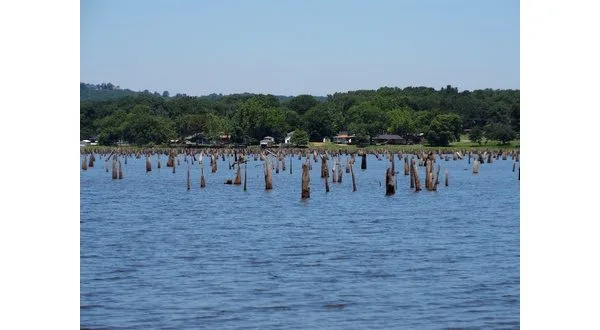
Arkansas will begin testing surface waters for PFAS using $1.8 million in grant funding. (Mary Hennigan/Arkansas Advocate)
The Arkansas Natural Resources Commission approved a $1.8 million grant to test surface waters for PFAS, the first known statewide effort to catalogue potential contamination from these “forever chemicals.”
PFAS, which stands for per- and polyfluoroalkyl substances, are a group of thousands of chemicals that don’t break down naturally and have been linked to a number of health concerns, such as cancer. Revelations of PFAS’ health implications – and how chemical companies knew for decades about the dangers they posed – have led to thousands of lawsuits, with many claiming it caused cancer. States, including Arkansas, have also sued.
The Division of Environmental Quality will use the funding to test surface waters for contamination.
DEQ submitted a pilot project proposal to the commission last year requesting funds from the emerging contaminants allocation of the state revolving loan fund, said Melony Martinez, Department of Energy and Environment spokesperson. The multi-year project will use a “phased approach to evaluate potential sources of PFAS” along with how it enters state waters.
“DEQ proposes to evaluate the status of PFAS in Arkansas’ waters before considering implementation of monitoring requirements, pretreatment requirements, or other permit conditions for PFAS as recommended by the EPA,” Martinez said.
The Environmental Protection Agency under the Biden administration moved aggressively to regulate PFAS in drinking water and surface waters, and classified the chemicals as a hazardous substance under the federal Superfund law.
The Trump EPA has begun efforts to roll back some of those policies. The EPA announced last week that drinking water limits on four PFAS chemicals would be scrapped, while limits on PFOA and PFOS – two of the most common chemicals in the group – would be kept, but would not go into effect until 2031, two years later than originally scheduled.
However, the EPA also said in April that it plans to take extensive action on PFAS.
“We are tackling PFAS from all of EPA’s program offices, advancing research and testing, stopping PFAS from getting into drinking water systems, holding polluters accountable, and providing certainty for passive receivers,” EPA Administrator Lee Zeldin said in a press release.
The EPA plans to list PFAS on the Toxic Release Inventory, a list of hazardous chemicals and substances, while making efforts to hold polluters responsible for PFAS contamination, according to the release.
Arkansas, Tennessee, Wyoming and Washington D.C. do not have existing or planned PFAS standards or limits for drinking water, according to an April report by the Environmental Council of the States, a national nonprofit, nonpartisan association of state environmental agency leaders.
Stacie Wassell, head of DEQ’s Office of Water Quality, told commissioners Wednesday that identifying and addressing PFAS contamination at the source was more cost-effective than trying to do so during the drinking water treatment process.
“It would be much cheaper to prevent it from contaminating our waters of the state than to remove it on the backside after it’s already been contaminated,” Wassell said.
State regulators have suspected that sources of PFAS contamination exist in the state, outside of two known sites – the Little Rock Air Force Base in Jacksonville and a former BASF facility in West Memphis.
“There are likely numerous other AFFF contamination sites in Arkansas that are yet to be investigated,” according to a DEQ memo written in March 2023 that was obtained via an Arkansas Freedom of Information Act request.
“At present E&E has no information regarding dumping sites or industrial users of PFAs,” the memo reads. “Industrial contamination sites likely exist in Arkansas, but due to lack of funding, equipment and human capital, no concerted, widespread investigation of PFAs contamination has occurred. …To date no field work has been done regarding PFAs.”
AFFF is a type of firefighting foam used by the military and other entities due to its efficiency in putting out jet fuel fires, and is a leading cause of PFAS pollution.
To view this story, or for more news updates from Arkansas Advocate, click here.
WebReadyTM Powered by WireReady® NSI










